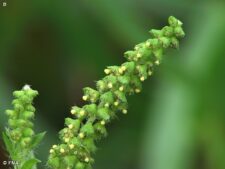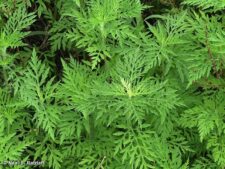
COMMON RAGWEED
Ambrosia artemisiifolia
SUNFLOWER FAMILY (Asteraceae)
 Identification
Identification
- Flowering time - July, August, September
- Common in disturbed areas at FF & NW
- Elongated green flower heads at tips of branches
- Fern-like leaves
- See comments for comparison with other ragweeds
This native annual, a hairy plant, usually less than 4 feet tall, has deeply dissected, fern-like leaves (C) and numerous elongated clusters of flower heads (A). The yellow male flowers are tiny inverted disks on long spikes (B). The inconspicuous female flowers are just below the male flower heads.
Common along road-sides and in disturbed areas at Fontenelle Forest and Neale Woods, especially near water. It flowers from July through September.
We have another very similar ragweed species in our area, Western Ragweed (Ambrosia psilostachya). It is described as having less branched stems with leaves a bit less finely divided, subtle features that aren’t very reliable. The best way to separate them involves destruction of the plant by pulling it and looking at the roots. Western Ragweed (A. psilostachya) is a perennial plant with roots that have branching rhizomes. Common Ragweed (A.artemisiifolia) is an annual with a single,long unbranched taproot. Separation from its much larger cousin, Giant Ragweed (A. trifida) is easier because it has large leaves with 3-5 lobes that are not at all fern-like
The pollen from common and giant ragweed is a major cause of hay fever in our area.
The content of NatureSearch is provided by dedicated volunteer Naturalists of Fontenelle Forest who strive to provide the most accurate information available. Contributors of the images retain their copyrights. The point of contact for this page is: Roland Barth.


